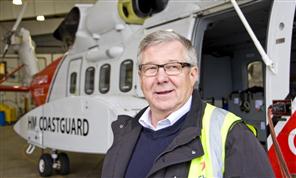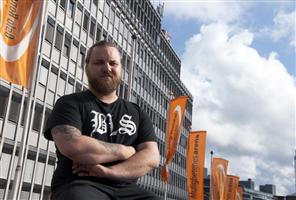Safer helicopter flights with new simulator centre
19.11.2013 15:47:25A new simulator centre for training on the Sikorsky S-92 opened in Stavanger this autumn. The centre will be a great benefit to the Norwegian helicopter community and increase flight safety on the continental shelf, argue helicopter experts.
For mer informasjon

Words: Atle Espen Helgesen
Sola, Norway
FlightSafety International's new simulator centre at Stavanger airport Sola opened officially in September, and operatively in October. The training centre, which is the first of its kind in Norway, will provide better and more efficient training of helicopter pilots, which in turn will increase flight safety to and from the shelf.
"The simulator centre is the result of a collaboration that began over four years ago. With the increase in Sikorsky craft in offshore traffic, we needed a S-92 training simulator in Norway," stated FlightSafety International's Director of Helicopter Business Development David Powell.
During the official opening of the centre, he pointed out that Erik Hamremoen of Statoil and Ketil Karlsen of Industri Energi had been the driving forces for bringing the simulator centre to Norway. "Their efforts have made the vision a reality," said Powell.
The Sikorsky S-92 helicopter was introduced in 2005, and is currently the most frequently used helicopter on the Norwegian shelf, with 31 craft in traffic.
Focus on safety
Erik Hamremoen, Statoil's Flight Safety Manager, and head of the Norwegian Oil and Gas Association's aviation network, assures the Industri Energi trade journal that oil companies are constantly seeking to increase helicopter safety on the shelf.
"The new training centre at Sola represents a milestone in terms of both quality and safety in offshore helicopter transport. The new simulator maximizes pilots' learning. At the same time, crews no longer have to travel far to receive the necessary training. This is cost-efficient, and results in higher quality," he says.
Sola, Norway
FlightSafety International's new simulator centre at Stavanger airport Sola opened officially in September, and operatively in October. The training centre, which is the first of its kind in Norway, will provide better and more efficient training of helicopter pilots, which in turn will increase flight safety to and from the shelf.

"The simulator centre is the result of a collaboration that began over four years ago. With the increase in Sikorsky craft in offshore traffic, we needed a S-92 training simulator in Norway," stated FlightSafety International's Director of Helicopter Business Development David Powell.
During the official opening of the centre, he pointed out that Erik Hamremoen of Statoil and Ketil Karlsen of Industri Energi had been the driving forces for bringing the simulator centre to Norway. "Their efforts have made the vision a reality," said Powell.
The Sikorsky S-92 helicopter was introduced in 2005, and is currently the most frequently used helicopter on the Norwegian shelf, with 31 craft in traffic.
Focus on safety
Erik Hamremoen, Statoil's Flight Safety Manager, and head of the Norwegian Oil and Gas Association's aviation network, assures the Industri Energi trade journal that oil companies are constantly seeking to increase helicopter safety on the shelf.
"The new training centre at Sola represents a milestone in terms of both quality and safety in offshore helicopter transport. The new simulator maximizes pilots' learning. At the same time, crews no longer have to travel far to receive the necessary training. This is cost-efficient, and results in higher quality," he says.
Hamremoen explains that all helicopter pilots who fly on the Norwegian shelf are under an obligation to complete at least eight hours of simulator training every six months.
"We have worked strategically with Industri Energi to bring such a training centre to Norway. It has always been important to the association's helicopter expert Ketil Karlsen that passengers be exposed to the least possible risk. The best pilot training and use of state-of-the-art technology are key to this," states the former Sea King pilot.
Hamremoen points out that they have never demanded a simulator here. "But we ran a business case that makes it profitable. The simulator is now in place. This shows that constructive collaboration between oil companies and trade unions yields results," says Hamremoen.
Ketil Karlsen, who currently runs Industri Energi's office in Brussels, is very pleased that the Sikorsky simulator is in place at Sola. He says that this has been important because this was a major recommendation in both Sintef's last helicopter study and by public committees that reviewed safety.
"A simulator will allow pilots to conduct the type of training that is not possible in real life. This will result in safer operations. Bringing the simulator to Norway has been important because it is expensive to send pilots to the USA or other countries to train. The closer the simulator, the easier it is to use it," says Karlsen.
He believes that it will now be possible to build a simulator cluster at Sola.
"The S-92 simulator is already fully-booked. This shows that the business case was sound. This is why I think we will be seeing more simulators here. In the long-term, it will be possible to build a simulator cluster at Sola, possibly for helicopters, ships, cranes and drilling. Norway has the best safety culture and thus the best foundation for providing training," he says.
Unique work
The new full-motion Level-D simulator at Sola is among the most advanced helicopter simulators in existence. With fantastic graphics and a cockpit that is identical to the real version, pilots will find this training to be very close to reality.
The centre also offers procedure training, both in a classroom and in a so-called cockpit trainer. Technicians will eventually also train at the centre, both in simulators and with a real craft they can work on.
Henrik Solvorn Fjeldsbø has assumed responsibility for helicopter matters at Industri Energi. He believes that the centre will benefit the Norwegian helicopter community, and increase Norwegian offshore helicopter safety, which is already world-class.
"Here it will be possible to train with completely different scenarios than in reality. You can set up complex and demanding training situations for pilots, so that they are prepared for unforeseen situations during flight."
He believes that it will now be possible to build a simulator cluster at Sola.
"The S-92 simulator is already fully-booked. This shows that the business case was sound. This is why I think we will be seeing more simulators here. In the long-term, it will be possible to build a simulator cluster at Sola, possibly for helicopters, ships, cranes and drilling. Norway has the best safety culture and thus the best foundation for providing training," he says.
Unique work
The new full-motion Level-D simulator at Sola is among the most advanced helicopter simulators in existence. With fantastic graphics and a cockpit that is identical to the real version, pilots will find this training to be very close to reality.
The centre also offers procedure training, both in a classroom and in a so-called cockpit trainer. Technicians will eventually also train at the centre, both in simulators and with a real craft they can work on.

Henrik Solvorn Fjeldsbø has assumed responsibility for helicopter matters at Industri Energi. He believes that the centre will benefit the Norwegian helicopter community, and increase Norwegian offshore helicopter safety, which is already world-class.
"Here it will be possible to train with completely different scenarios than in reality. You can set up complex and demanding training situations for pilots, so that they are prepared for unforeseen situations during flight."
Fjeldsbø points out that the many helicopter accidents on the British shelf during the past few years demonstrate the importance of a constant focus and training on safety.
"When situations suddenly arise, pilots need to have had so much training that they react quickly and correctly," he says.